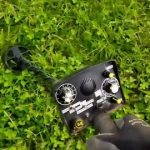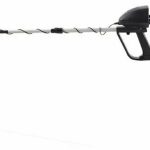Detecting tools have long been a crucial component of security measures, aiding in the identification and prevention of potential threats. As technological advancements continue to evolve at a rapid pace, new high-tech detecting tools have emerged, revolutionizing the way security is approached. These state-of-the-art tools have the capability to enhance security measures and provide advanced identification and detection of potential risks. In this article, we will explore the latest developments in detecting tools and their impact on security measures.
New high-tech detecting tools are revolutionizing security measures by providing advanced capabilities for identifying and preventing potential threats. These innovative tools utilize cutting-edge technologies such as artificial intelligence, machine learning, and advanced sensors to detect and analyze security risks in real-time. With the ability to adapt to evolving security challenges, these detecting tools offer enhanced accuracy and efficiency in threat detection, making them essential components of modern security systems. Additionally, these tools can integrate with existing security infrastructure, providing seamless and comprehensive protection for various environments and applications. Overall, the adoption of these new high-tech detecting tools signifies a significant advancement in security measures, offering a more proactive and effective approach to threat detection and prevention.
The Essential Guide to Detecting Tools for DIY Projects

The Essential Guide to Detecting Tools for DIY Projects provides detailed information on various tools and their uses for DIY enthusiasts. It covers a wide range of tools such as measuring tools, cutting tools, fastening tools, and power tools. The guide also includes tips on how to choose the right tools for different projects and how to maintain and care for them. Additionally, it offers advice on detecting the quality of tools and how to use them safely. It is a valuable resource for DIYers looking to build or expand their toolkit.
Top 10 Must-Have Detecting Tools for Home Improvement

1. Stud Finder – This essential tool helps locate the wooden studs behind drywall, making it easier to securely hang heavy objects like shelves or TVs.
2. Digital Laser Measure – A digital laser measure provides accurate measurements for DIY projects such as hanging pictures, installing shelves, or determining the square footage of a room.
3. Voltage Tester – This tool is crucial for detecting live electrical currents, ensuring safety when working on electrical projects around the home.
4. Pipe and Wire Detector – Use a pipe and wire detector to locate hidden pipes, electrical wires, and metal studs before drilling or nailing into walls.
5. Thermal Imaging Camera – This advanced tool can detect temperature variations in walls, floors, and ceilings, providing valuable insights into insulation performance and detecting potential water leaks.
6. Moisture Meter – A moisture meter is essential for identifying water damage, leaky pipes, and damp areas in walls, ceilings, and floors.
7. Digital Multimeter – This versatile tool measures voltage, current, and resistance, making it indispensable for troubleshooting electrical and electronic issues in the home.
8. Noise Cancelling Ear Muffs – Protect your ears from loud power tools and machinery while working on DIY projects with a pair of noise-canceling ear muffs.
9. Magnetic Pickup Tool – This handy tool is ideal for retrieving dropped screws, nails, and other small metal objects from hard-to-reach places.
10. Telescoping Inspection Mirror – An inspection mirror with a telescoping handle allows for easy visual inspection of tight spaces, such as behind appliances or under furniture, without having to strain or contort your body.
How to Choose the Right Detecting Tools for Your Workshop

When choosing detecting tools for your workshop, consider the type of materials you regularly work with and the specific tasks you need to perform. Look for high-quality tools from reputable manufacturers to ensure reliability and accuracy. It’s important to choose tools that are appropriate for the size and scale of your projects, as well as ones that are comfortable and easy to use for extended periods of time. Additionally, consider the availability of replacement parts and customer support when making your selections. Lastly, consider investing in versatile tools that can be used for multiple purposes to maximize their value in your workshop.
Detecting Tools 101: A Beginner’s Guide to Basic Equipment

Detecting Tools 101: A Beginner’s Guide to Basic Equipment is a comprehensive resource that covers the essential tools used for detecting various substances. The guide includes information on metal detectors, ground-penetrating radar, and other technologies commonly used for detecting materials and objects. It provides detailed descriptions of each tool, their functions, and how to use them effectively. This guide is ideal for beginners looking to familiarize themselves with the fundamental equipment used in the detection industry.
The Benefits of Investing in Quality Detecting Tools
Investing in quality detecting tools can provide numerous benefits. These tools can help in identifying potential issues or problems early on, allowing for timely intervention and maintenance. This can ultimately save time and money by preventing costly repairs and downtime. Additionally, quality detecting tools can improve the accuracy and precision of measurements, leading to better decision-making and more efficient operations. Investing in these tools can also enhance the safety and reliability of equipment and processes, leading to improved overall performance and productivity. Overall, the benefits of investing in quality detecting tools are numerous and can have a significant impact on the success and effectiveness of various industries and operations.
Detecting Tools: The Key to Efficient and Accurate Measurements
Detecting tools are essential for efficient and accurate measurements in a wide range of industries. These tools can include items such as thermometers, measuring tape, calipers, scales, and more. By using the appropriate detecting tools, professionals can ensure that their measurements are precise, reliable, and consistent.
In industries such as manufacturing, construction, engineering, and science, accurate measurements are crucial for quality control, safety, and meeting regulatory standards. Detecting tools help professionals to gather data, monitor conditions, and make informed decisions based on precise measurements.
Moreover, efficient detection tools can save time and resources by streamlining the measurement process and reducing the likelihood of errors. This is particularly important in industries where even small deviations from the standard can have significant impacts on the final product or outcome.
In conclusion, detecting tools play a vital role in ensuring that measurements are accurate and reliable. With the right tools, professionals can gather data with confidence and make decisions that drive quality, safety, and compliance.
Essential Detecting Tools for Electricians and Plumbers
See also: metal detectors for gold
Electricians and plumbers rely on essential detecting tools to efficiently locate and diagnose issues within electrical and plumbing systems. Some essential detecting tools for electricians include voltage testers, circuit tracers, and multimeters. These tools are used to test for the presence of electrical current, trace circuits, and measure voltage, current, and resistance in electrical systems.
For plumbers, essential detecting tools include leak detection equipment such as electronic leak detectors, pipe locators, and water pressure gauges. These tools help plumbers identify and locate leaks in pipes, as well as measure water pressure and flow rates in plumbing systems. Additionally, plumbers may also use inspection cameras and sewer line locators to visually inspect and locate blockages or damage in drains and sewer lines. These detecting tools are crucial for diagnosing and solving plumbing problems effectively.
Maximizing Productivity with the Right Detecting Tools
Maximizing productivity with the right detecting tools involves utilizing technology and equipment to efficiently and accurately identify and address issues. This can include using software to monitor and analyze data, as well as employing specialized devices for detecting specific elements or anomalies. By investing in and utilizing the most effective tools for detecting and diagnosing problems, businesses and individuals can minimize downtime, reduce errors, and optimize their overall output. This can result in significant cost savings and improved efficiency across a wide range of industries, from manufacturing and construction to healthcare and beyond.
The Latest Innovations in Detecting Tools and Technology
Recent advancements in detecting tools and technology include the development of highly sensitive sensors for detecting various substances, such as drugs, chemicals, and explosives. These sensors use cutting-edge technologies such as nanomaterials and microfluidics to achieve high levels of specificity and sensitivity.
Additionally, there have been significant improvements in imaging and spectroscopy techniques, allowing for faster and more accurate detection of anomalies and abnormalities in various materials and substances. These advancements have enabled the development of portable and non-invasive detection tools for medical diagnostics, security screening, and environmental monitoring.
Furthermore, machine learning and artificial intelligence are being increasingly utilized in the development of smart detection systems that can analyze complex data and make real-time decisions. These systems have the potential to revolutionize the way detection tools are used in various industries, making them more efficient and effective.
Overall, the latest innovations in detecting tools and technology are pushing the boundaries of what is possible in terms of sensitivity, accuracy, and speed, and have the potential to significantly impact a wide range of applications from healthcare to national security.
DIY Detecting: Using Tools to Tackle Household Projects
DIY Detecting: Using Tools to Tackle Household Projects is a comprehensive guide for DIY enthusiasts looking to improve their skills and tackle a variety of home projects. The book covers essential tools, safety tips, and step-by-step instructions for common household projects such as hanging pictures, assembling furniture, and basic plumbing and electrical work. It also includes helpful tips for choosing the right tools and materials for each project, as well as troubleshooting common issues that may arise. Whether you’re a beginner or an experienced DIYer, this book is a valuable resource for honing your skills and completing projects with confidence.












